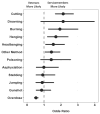Suicide Attempt Characteristics Among Veterans and Active-Duty Service Members Receiving Mental Health Services: A Pooled Data Analysis
- PMID: 26740909
- PMCID: PMC4699574
- DOI: 10.1080/21635781.2015.1093981
Suicide Attempt Characteristics Among Veterans and Active-Duty Service Members Receiving Mental Health Services: A Pooled Data Analysis
Abstract
Past suicidal behaviors are among the strongest and most consistent predictors of eventual suicide and may be particularly salient in military suicide. The current study compared characteristics of suicide attempts in veterans (N = 746) and active-duty service members (N = 1,013) receiving treatment for acute suicide risk. Baseline data from six randomized controlled trials were pooled and analyzed using robust regression. Service members had greater odds of having attempted suicide relative to veterans, though there were no differences in number of attempts made. Service members also had higher rates of premilitary suicide attempts and nonsuicidal self-injury (NSSI). Veterans disproportionately attempted suicide by means of overdose. In veterans, combat deployment was associated with lower odds of lifetime suicide attempt, while history of NSSI was associated with greater attempt odds. Neither was significantly associated with lifetime suicide attempt in service members. Implications for suicide assessment and treatment are discussed.
Figures

Similar articles
-
Non-suicidal self-injury and suicidal thoughts and behaviors: A study of the explanatory roles of the interpersonal theory variables among military service members and veterans.J Consult Clin Psychol. 2018 Jan;86(1):56-68. doi: 10.1037/ccp0000262. Epub 2017 Nov 27. J Consult Clin Psychol. 2018. PMID: 29172592 Free PMC article.
-
Nonsuicidal self-injury as a prospective predictor of suicide attempts in a clinical sample of military personnel.Compr Psychiatry. 2015 May;59:1-7. doi: 10.1016/j.comppsych.2014.07.009. Epub 2014 Jul 11. Compr Psychiatry. 2015. PMID: 25749478
-
Suicide attempts before joining the military increase risk for suicide attempts and severity of suicidal ideation among military personnel and veterans.Compr Psychiatry. 2014 Apr;55(3):534-41. doi: 10.1016/j.comppsych.2013.10.006. Epub 2013 Oct 22. Compr Psychiatry. 2014. PMID: 24246604
-
The Association of Military Sexual Harassment/Assault With Suicide Ideation, Plans, Attempts, and Mortality Among US Service Members/Veterans: A Meta-Analysis.Trauma Violence Abuse. 2023 Oct;24(4):2616-2629. doi: 10.1177/15248380221109790. Epub 2022 Jun 28. Trauma Violence Abuse. 2023. PMID: 35763372 Review.
-
Prevention of suicide and attempted suicide in Denmark. Epidemiological studies of suicide and intervention studies in selected risk groups.Dan Med Bull. 2007 Nov;54(4):306-69. Dan Med Bull. 2007. PMID: 18208680 Review.
Cited by
-
Qualitative analysis of participant experiences during an ecological momentary assessment study of nonsuicidal self-injury among veterans.Psychiatry Res. 2022 Apr;310:114437. doi: 10.1016/j.psychres.2022.114437. Epub 2022 Feb 12. Psychiatry Res. 2022. PMID: 35183989 Free PMC article.
-
Diagnostic Correlates of Nonsuicidal Self-Injury Disorder among Veterans with Psychiatric Disorders.Psychiatry Res. 2021 Feb;296:113672. doi: 10.1016/j.psychres.2020.113672. Epub 2020 Dec 28. Psychiatry Res. 2021. PMID: 33383275 Free PMC article.
-
Interpersonal stress and nonsuicidal self-injury disorder in veterans: An ecological momentary assessment study.Suicide Life Threat Behav. 2023 Aug;53(4):546-556. doi: 10.1111/sltb.12963. Epub 2023 Apr 13. Suicide Life Threat Behav. 2023. PMID: 37052380 Free PMC article.
-
Initial validation of brief measures of suicide risk factors: Common data elements used by the Military Suicide Research Consortium.Psychol Assess. 2018 Jun;30(6):767-778. doi: 10.1037/pas0000519. Epub 2017 Nov 13. Psychol Assess. 2018. PMID: 29130694 Free PMC article.
-
Non-suicidal self-injury and suicidal thoughts and behaviors: A study of the explanatory roles of the interpersonal theory variables among military service members and veterans.J Consult Clin Psychol. 2018 Jan;86(1):56-68. doi: 10.1037/ccp0000262. Epub 2017 Nov 27. J Consult Clin Psychol. 2018. PMID: 29172592 Free PMC article.
References
-
- Andover MS, Primack JM, Gibb BE, Pepper CM. An examination of non-suicidal self-injury in men: Do men differ from women in basic NSSI characteristics? Archives of Suicide Research. 2010;14:79–88. - PubMed
-
- Berman A, Bradley J, Carroll B, Certain RG, Gabrelcik JC, Green R, Werbel A. The challenge and the promise: Strengthening the force, preventing suicide, and saving lives: Final Report of the Department of Defense Task Force on the Prevention of Suicide by Members of the Armed Forces. Falls Church, VA: Defense Health Board; 2010.
-
- Britton PC, Bryan CJ, Valenstein M. Motivational Interviewing for Means Restriction Counseling With Patients at Risk for Suicide. Cognitive and Behavioral Practice. 2014 doi: 10.1016/j.cbpra.2014.09.004. Advance online publication. - DOI
Grants and funding
LinkOut - more resources
Full Text Sources
Other Literature Sources
Molecular Biology Databases
Miscellaneous
